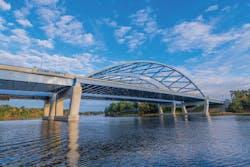No. 10 - Whittier Bridge
Travelers along I-95 driving from Massachusetts to New Hampshire will inevitably cross over the Merrimack River near Amesbury.
What motorists may not realize is that the current structure over the river is something never before seen in the Bay State: a network tied-arch bridge, with a shared-use path along the interstate.
The picturesque 1,400-ft structure over the river is none other than the new John Greenleaf Whittier Memorial Bridge, which was completed in October 2018 as part of a larger 4-mile improvement project along I-95. Back in 2012, the Massachusetts DOT (MassDOT) saw fit to widen this stretch of the interstate from three lanes to four lanes in each direction. The challenge posed by this project was how the existing Whittier Bridge could be replaced and widened without impacting traffic capacity.
“It wasn’t immediately obvious how to maintain traffic and replace [the bridge] to get the four lanes in each direction,” John Smith, project manager for HNTB, told Roads & Bridges. “We did figure out a way to replace the existing bridge with two side-by-side bridges and maintain the level of service that had always been there, until we were eventually able to complete the bridges and make it four lanes in each direction.” The strategy for completing work on the bridge included building the northbound span of the bridge adjacent to the old bridge, shifting north and southbound traffic onto that structure while the old bridge was demolished, and finally building the second span that would serve as the southbound bridge. Eliminating the pinch point at the bridge allowed the team to widen the interstate over the entire 4 miles, which, in addition to the four lanes in each direction, included full shoulders, full breakdown lanes, and a shared-use bike and pedestrian path.
Due to the accelerated timeline for construction, only parts of the bridge design were finished before construction began in order to keep up with project deadlines. “Design was still progressing while we were constructing—that was the only way to meet schedule,” Smith said. “So we partnered with MassDOT to have lots of early release for construction packages. We were putting foundations in before we had final approval for design of the bridge.”
One of the more complex aspects of the bridge’s design for the tied arches was confirming the redundancy of the structural system in the case of damage to the tie beams or loss of hanger cables. “Our design was based on a rigorous dynamic analysis that allowed us to accommodate the sudden loss of even two of those inclined hangers, or any one plate on the tie-girders,” Smith explained. “The design challenge was doing an analysis so that even in the event of a catastrophic loss of major parts of the structure, it would still function.” Tie girder redundancy on the arches was achieved by providing a stitched-up steel box section that can afford the loss of one plate of the section. Longitudinally post-tensioned, precast deck panels composite with the tie girders provided an additional level of redundancy.
Among the most challenging aspects of building the bridge was erecting the complex twin 480-ft network-tied arches over the river. This particular bridge design was chosen to hearken back to the previously existing cantilever through-truss arch bridge. Fortunately for MassDOT, HNTB had extensive experience designing a network tied arch, as the firm has designed eight of the 14 bridges of the same type that exist in the U.S. The new Whittier Bridge brings that total to nine.
The original request for proposal documents envisioned floating the arches to the construction site and hoisting them into place with barge-mounted cranes. “But because of the tidal nature of the river, we determined that was impossible, so we built it with a launch girder.” Aside from the tide fluctuations, the need to maintain a 150-ft navigable channel and working in a constrained space made the barges unworkable. Seeking an alternative, HNTB worked with Genesis Engineering as a consultant for the erection process to develop a unique approach that implemented launch girders and overhead gantry cranes to put the new arches into place. The team used Mi-Jack custom 105-ft rolling gantries to erect both the precast deck and the steel, building the bridge from land on both sides.
Throughout construction, the team wanted to ensure they minimized in-water environmental impacts. This consisted of limiting in-water work to not disturb the migration and mating patterns of the eastern sturgeon, an endangered species in the Merrimack River. One solution to ensure limited impact was for the pier plinths to use granite-faced precast panels doubling as both form liners and cofferdams, which served as an accelerated bridge construction technique.
In the face of extensive challenges, the project team was able to successfully execute the complicated replacement of the Whittier Bridge to completion, providing the new structure with a 75-year design life to accommodate motorists along a widened I-95 for years to come.
